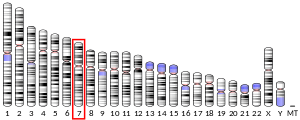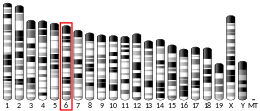CNTNAP2
Contactin-associated protein-like 2 is a protein that in humans is encoded by the CNTNAP2 gene.[5][6][7] Since the most recent reference human genome GRCh38, CNTNAP2 is the longest gene in the human genome [8]
This gene encodes a member of the neurexin family which functions in the vertebrate nervous system as cell adhesion molecules and receptors. This protein, like other neurexin proteins, contains epidermal growth factor repeats and laminin G domains. In addition, it includes an F5/8 type C domain, discoidin/neuropilin- and fibrinogen-like domains, thrombospondin N-terminal-like domains and a putative PDZ binding site. This protein is localized at the juxtaparanodes of myelinated axons and associated with potassium channels. It may play a role in the local differentiation of the axon into distinct functional subdomains. This gene encompasses almost 1.6% of chromosome 7 and is one of the largest genes in the human genome.[9] It may represent a positional candidate gene for the DFNB13 form of nonsyndromic deafness.[7]
Clinical significance
CNTNAP2 has been associated with autism spectrum disorder but accounts for very few cases.[10][11][12] CNTNAP2 may also be related to a disorder called specific language impairment.[13]
Recessive mutations in CNTNAP2 result in a disorder that resembles Pitt–Hopkins syndrome.[14][15]
Interactions
CNTNAP2 has been shown to interact with CNTN2.[16]
References
- ENSG00000278728 GRCh38: Ensembl release 89: ENSG00000174469, ENSG00000278728 - Ensembl, May 2017
- GRCm38: Ensembl release 89: ENSMUSG00000039419 - Ensembl, May 2017
- "Human PubMed Reference:". National Center for Biotechnology Information, U.S. National Library of Medicine.
- "Mouse PubMed Reference:". National Center for Biotechnology Information, U.S. National Library of Medicine.
- Poliak S, Gollan L, Martinez R, Custer A, Einheber S, Salzer JL, Trimmer JS, Shrager P, Peles E (December 1999). "Caspr2, a new member of the neurexin superfamily, is localized at the juxtaparanodes of myelinated axons and associates with K+ channels". Neuron. 24 (4): 1037–47. doi:10.1016/S0896-6273(00)81049-1. PMID 10624965.
- Nagase T, Ishikawa K, Suyama M, Kikuno R, Hirosawa M, Miyajima N, Tanaka A, Kotani H, Nomura N, Ohara O (December 1998). "Prediction of the coding sequences of unidentified human genes. XII. The complete sequences of 100 new cDNA clones from brain which code for large proteins in vitro". DNA Research. 5 (6): 355–64. doi:10.1093/dnares/5.6.355. PMID 10048485.
- "Entrez Gene: CNTNAP2 contactin associated protein-like 2".
- Ashley, Euan A. (16 August 2016). "Towards precision medicine". Nature Reviews Genetics. 17 (9): 507–522. doi:10.1038/nrg.2016.86. PMID 27528417.
- Helmrich A, Ballarino M, Tora L (December 2011). "Collisions between replication and transcription complexes cause common fragile site instability at the longest human genes" (PDF). Molecular Cell. 44 (6): 966–77. doi:10.1016/j.molcel.2011.10.013. PMID 22195969.
- Alarcón M, Abrahams BS, Stone JL, Duvall JA, Perederiy JV, Bomar JM, Sebat J, Wigler M, Martin CL, Ledbetter DH, Nelson SF, Cantor RM, Geschwind DH (January 2008). "Linkage, association, and gene-expression analyses identify CNTNAP2 as an autism-susceptibility gene". American Journal of Human Genetics. 82 (1): 150–9. doi:10.1016/j.ajhg.2007.09.005. PMC 2253955. PMID 18179893. Archived from the original on 2008-01-16. Lay summary – UCLA Newsroom (2008-01-10).
- Arking DE, Cutler DJ, Brune CW, Teslovich TM, West K, Ikeda M, Rea A, Guy M, Lin S, Cook EH, Chakravarti A (January 2008). "A common genetic variant in the neurexin superfamily member CNTNAP2 increases familial risk of autism". American Journal of Human Genetics. 82 (1): 160–4. doi:10.1016/j.ajhg.2007.09.015. PMC 2253968. PMID 18179894. Archived from the original on 2008-01-16. Lay summary – Johns Hopkins Medicine (2008-01-22).
- Bakkaloglu B, O'Roak BJ, Louvi A, Gupta AR, Abelson JF, Morgan TM, Chawarska K, Klin A, Ercan-Sencicek AG, Stillman AA, Tanriover G, Abrahams BS, Duvall JA, Robbins EM, Geschwind DH, Biederer T, Gunel M, Lifton RP, State MW (January 2008). "Molecular cytogenetic analysis and resequencing of contactin associated protein-like 2 in autism spectrum disorders". American Journal of Human Genetics. 82 (1): 165–73. doi:10.1016/j.ajhg.2007.09.017. PMC 2253974. PMID 18179895. Archived from the original on 2008-01-16.
- Vernes SC, Newbury DF, Abrahams BS, Winchester L, Nicod J, Groszer M, Alarcón M, Oliver PL, Davies KE, Geschwind DH, Monaco AP, Fisher SE (November 2008). "A functional genetic link between distinct developmental language disorders". The New England Journal of Medicine. 359 (22): 2337–45. doi:10.1056/NEJMoa0802828. PMC 2756409. PMID 18987363. Lay summary – ScienceNOW Daily News.
- Peippo M, Ignatius J (April 2012). "Pitt-Hopkins Syndrome". Molecular Syndromology. 2 (3–5): 171–180. doi:10.1159/000335287. PMC 3366706. PMID 22670138.
- Zweier C, de Jong EK, Zweier M, Orrico A, Ousager LB, Collins AL, et al. (November 2009). "CNTNAP2 and NRXN1 are mutated in autosomal-recessive Pitt-Hopkins-like mental retardation and determine the level of a common synaptic protein in Drosophila". American Journal of Human Genetics. 85 (5): 655–66. doi:10.1016/j.ajhg.2009.10.004. PMC 2775834. PMID 19896112.
- Traka M, Goutebroze L, Denisenko N, Bessa M, Nifli A, Havaki S, Iwakura Y, Fukamauchi F, Watanabe K, Soliven B, Girault JA, Karagogeos D (September 2003). "Association of TAG-1 with Caspr2 is essential for the molecular organization of juxtaparanodal regions of myelinated fibers". The Journal of Cell Biology. 162 (6): 1161–72. doi:10.1083/jcb.200305078. PMC 2172849. PMID 12975355.
External links
Further reading
- Nakabayashi K, Scherer SW (April 2001). "The human contactin-associated protein-like 2 gene (CNTNAP2) spans over 2 Mb of DNA at chromosome 7q35". Genomics. 73 (1): 108–12. doi:10.1006/geno.2001.6517. PMID 11352571. S2CID 16120451.
- Spiegel I, Salomon D, Erne B, Schaeren-Wiemers N, Peles E (June 2002). "Caspr3 and caspr4, two novel members of the caspr family are expressed in the nervous system and interact with PDZ domains". Molecular and Cellular Neurosciences. 20 (2): 283–97. doi:10.1006/mcne.2002.1110. PMID 12093160.
- Nakayama M, Kikuno R, Ohara O (November 2002). "Protein-protein interactions between large proteins: two-hybrid screening using a functionally classified library composed of long cDNAs". Genome Research. 12 (11): 1773–84. doi:10.1101/gr.406902. PMC 187542. PMID 12421765.
- Denisenko-Nehrbass N, Oguievetskaia K, Goutebroze L, Galvez T, Yamakawa H, Ohara O, Carnaud M, Girault JA (January 2003). "Protein 4.1B associates with both Caspr/paranodin and Caspr2 at paranodes and juxtaparanodes of myelinated fibres". The European Journal of Neuroscience. 17 (2): 411–6. doi:10.1046/j.1460-9568.2003.02441.x. PMID 12542678.
- Verkerk AJ, Mathews CA, Joosse M, Eussen BH, Heutink P, Oostra BA (July 2003). "CNTNAP2 is disrupted in a family with Gilles de la Tourette syndrome and obsessive compulsive disorder". Genomics. 82 (1): 1–9. doi:10.1016/S0888-7543(03)00097-1. PMID 12809671.
- Traka M, Goutebroze L, Denisenko N, Bessa M, Nifli A, Havaki S, Iwakura Y, Fukamauchi F, Watanabe K, Soliven B, Girault JA, Karagogeos D (September 2003). "Association of TAG-1 with Caspr2 is essential for the molecular organization of juxtaparanodal regions of myelinated fibers". The Journal of Cell Biology. 162 (6): 1161–72. doi:10.1083/jcb.200305078. PMC 2172849. PMID 12975355.
- Fu GK, Wang JT, Yang J, Au-Young J, Stuve LL (July 2004). "Circular rapid amplification of cDNA ends for high-throughput extension cloning of partial genes". Genomics. 84 (1): 205–10. doi:10.1016/j.ygeno.2004.01.011. PMID 15203218.
- Strauss KA, Puffenberger EG, Huentelman MJ, Gottlieb S, Dobrin SE, Parod JM, Stephan DA, Morton DH (March 2006). "Recessive symptomatic focal epilepsy and mutant contactin-associated protein-like 2". The New England Journal of Medicine. 354 (13): 1370–7. doi:10.1056/NEJMoa052773. PMID 16571880.
- Belloso JM, Bache I, Guitart M, Caballin MR, Halgren C, Kirchhoff M, Ropers HH, Tommerup N, Tümer Z (June 2007). "Disruption of the CNTNAP2 gene in a t(7;15) translocation family without symptoms of Gilles de la Tourette syndrome". European Journal of Human Genetics. 15 (6): 711–3. doi:10.1038/sj.ejhg.5201824. PMID 17392702.



